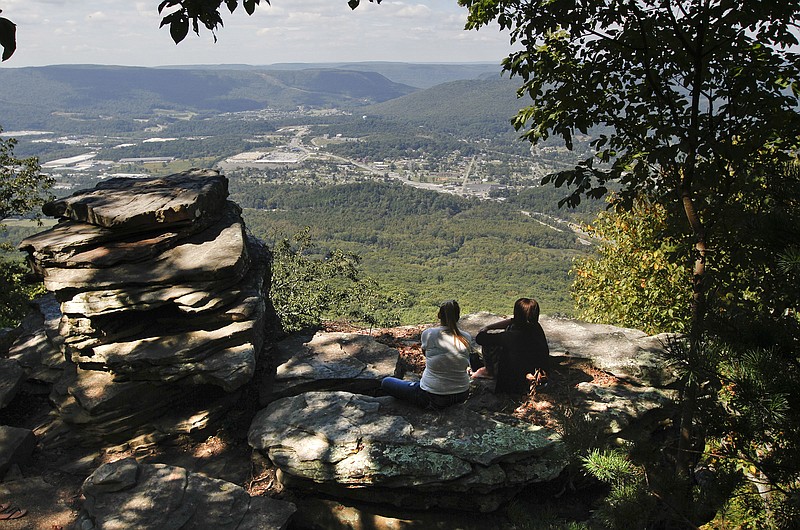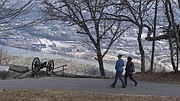Chattanooga's air quality, once rated among the worst in the nation, continues to improve, according to a report released Wednesday by the American Lung Association.
"Chattanooga had no unhealthy days for short-term particle pollution and is ranked one of the cleanest cities in the nation," according to a statement released by the ALA.
Overall, the city received passing grades for the three most common forms of hazardous air pollution - ozone pollution, year-round particle pollution, and short-term particle pollution.
"We were the most polluted city in America for particulates, and we've gone from the most polluted city in America to being one of the cleanest; that's a good story," said Bob Colby, director of the Hamilton County Air Pollution Control Board, which administers air pollution laws locally.
Nationally, the 18th annual report concluded that ozone and year-round particle levels were lower overall, offset by short-term spikes in particle pollution, often related to wildfires or droughts.
While pollution levels went down, the lung association said they still pose a risk to the health of at least 43 million people and continued efforts are needed to lower them further.
"People in the Chattanooga area are at risk of unhealthful levels of long-term particle pollution, putting them at risk for premature death and other serious health effects such as asthma attacks, worsened COPD symptoms and cardiovascular harm," the lung association said in a statement.
Not surprisingly, the state's four major metropolitan counties had the worst air pollution problems. The lung association gave Chattanooga a passing grade of C overall, the same as Davidson County (Nashville). Knox County (Knoxville) received a B, while Shelby County (Memphis) was rated a D.
Chattanooga had five "orange" days during which the ozone level was high enough to cause problems for children, those who are active outdoors, older adults, and anyone with heart or lung disease such as asthma. But there were no days rated as red or purple, indicating a more serious pollution level.
That will probably change next year.
The data used in the report was from 2013 to 2015, so it does not include the impact of last year's persistent wildfires, which often left a cloud of smoke across much of the metro area.
"Wildfires are a huge issue," said Heather Wehrheim, advocacy director for Tennessee for the lung association. "It will be interesting how that impacts the data when it is released."
"It will be a problem," the air pollution control board's Colby said. "We're going to have some red days in their data next year. It won't be on EPA's data because it will be flagged as an exceptional event, because EPA recognizes it is beyond the control of man. But the ALA takes the stance that it should be counted because people are breathing that air."
Compared to the previous year, the city's short-term particle pollution, or soot, levels declined. Soot comes from coal-fired plants as well as older diesel engines, wildfires and wood-burning devices. Because the particles are very small, they can lodge deep within the lungs and cause asthma attacks, heart problems and strokes, as well as lung cancer, according to the lung association.
Lung association officials praised the impact of the federal Clean Air Act for lowering emissions from coal-fired generating plants, as well as stricter pollution controls on other industries and motor vehicles.
"The Lung Association in Tennessee calls on President [Donald] Trump, EPA Administrator Scott Pruitt and members of Congress to fully fund, implement and enforce the Clean Air Act for all air pollutants," Wehrheim said, "including those that drive climate change and make it harder to ensure healthy air for all Americans."
Colby credited a changing mix of local industries plus less-polluting motor vehicles for much of the improvement. As an example, the Volkswagen auto assembly plant, which opened in 2011, is one of the least polluting in the world, as compared to the Wheland Foundry on South Broad Street with its open-air blast furnace, which ceased operations in 2003.
"We no longer have any industries burning coal," he said. "We no longer have any utilities, including TVA, burning any coal in close proximity to Chattanooga."
Much of the remaining air pollution locally comes from motor vehicles, Colby said, which is hard for local officials to change without major expenditures for new roadways. While engineers would like to get rid of all of the traffic stalled on Interstate 24 crossing Missionary Ridge in the afternoon, Colby said, "the traffic engineers will tell you that is happening just exactly by the book. There are two things going on there, one is a hill and the other is a curve, which is a double whammy that is always going to slow traffic down."
Overall, the worst city in the nation for pollution was Bakersfield, Calif., according to the report. Bakersfield ranked second for ozone pollution, second for year-round particle pollution, and first for short-term particle pollution. The Fresno-Madera metro area in California was right behind Bakersfield, and several other California cities, including Los Angeles and San Francisco, were in the bottom 20 in all three categories.
But the lung association reported that all of those cities also managed to reduce their ozone levels compared to the previous year.
Birmingham, Ala., and Baton Rouge, La., were the only two southeastern cities on the Worst 25 list.
Contact staff writer Steve Johnson at 423-757-6673, sjohnson@timesfreepress.com, on Twitter @stevejohnsonTFP, and on Facebook, www.facebook.com/noogahealth.
More Info
For more on this study, visit lung.org/sota.
HEALTH RISKS
Ozone PollutionIt may be hard to imagine that the most widespread pollutant in the U.S. is also one of the most dangerous—and invisible. Learn more about ozone.Particle PollutionEver look at dirty truck exhaust? Overwhelming evidence shows that particle pollution — like that coming from that exhaust smoke — can kill. Particle pollution can increase the risk of heart disease, lung cancer and asthma attacks and can interfere with the growth and work of the lungs. Learn more about particle pollution.Focusing on Children’s HealthChildren face special risks from air pollution because their lungs are growing and because they are so active. Learn more about children and air pollution.Disparities in the Impact of Air PollutionThe burden of air pollution is not evenly shared. Poorer people and some racial and ethnic groups are among those who often face higher exposure to pollutants. Learn more about disparities and air pollution.Living Near HighwaysBeing in heavy traffic, or living near a road, may be even more dangerous than being in other places in a community.Learn more about living near highways and air pollution.How to Protect YourselfYou can take steps to protect yourself and your family. Get 10 tips to protect yourself from unhealthy air.Going Beyond Ozone and Particle PollutionOzone and particle pollution are the most widespread, but they aren’t the only serious air pollutants. Others include carbon monoxide, lead, nitrogen dioxide, and sulfur dioxide, as well as scores of toxins such as mercury, arsenic, benzene, formaldehyde, and acid gases. However, the monitoring networks are not as widespread nationwide for the other pollutants. Learn more about these pollutants.Source: American Lung Association
AIR QUALITY FACTS
› More than 4 out of 10 people live where the air they breathe earned an F in State of the Air 2017.› More than 125 million people live in counties that received an F for either ozone or particle pollution in State of the Air 2017.› Breathing ozone irritates the lungs, resulting in something like a bad sunburn within the lungs.› Pollution from the traffic may put you at greater risk of harm.
CLEANEST CITIES
Six cities ranked on all three cleanest cities lists in 2013-2015. These cities had zero high ozone or high particle pollution days, and were among the 25 cities with the lowest year-round particle levels.Burlington-South Burlington, Vt.Cape Coral-Fort Myers-Naples, Fla.Elmira-Corning, N.Y.Honolulu, HawaiiPalm Bay-Melbourne-Titusville, Fla.Wilmington, N.C.
WORST CITIES
Ranked by ozone1. Los Angeles-Long Beach, Calif.2. Bakersfield, Calif.3. Fresno-Madera, Calif.4. Visalia-Porterville-Hanford, Calif.5. Phoenix-Mesa-Scottsdale, Ariz.6. Modesto-Merced, Calif.

